October 1: Mask Shortage in Iran as Coronavirus Cases Rise
Iran’s interior minister reported on September 30 that Iran is at risk of not having enough masks to protect its citizens from coronavirus. “Twenty million masks are produced each day but there are problems in securing the raw material for making them,” he said, adding, "it has been decided that the issue must be pursued and solved. Currently, a mask costs between 1,000 and 1,300 tomans to produce (between US¢25 and ¢31) but there are issues with how they are distributed to the people. So a team has been assigned to study the issue and report on the situation.”
At the beginning of the coronavirus outbreak in Iran in late February, the country suffered a severe shortage of masks and other health equipment, sparking fears among the public. Currently, such items are readily available in the country, although if a person wears one mask per day he will incur a cost of 30,000 tomans (over $7) per month, a heavy financial burden for large, underprivileged households in Iran.
But there are other problems regarding masks. “The distribution of masks…is not being done correctly,” announced Ali Fatemi, vice president of Iran’s Pharmacists Association on July 17. “We are facing an inconsistency. For instance, before coronavirus, Iran produced between 300,000 and 400,000 masks per day but now the production has reached seven million per day. It is only logical that the consumption has increased, but why are the masks not being distributed through the pharmacies?”
Fatemi emphasized that people must not wear masks for more than four or five hours “because the pores in the polymeric layer of the mask are of a certain size that prevents the virus from getting through it. When the humidity of breathing gets too high the mask becomes useless. And when this mask is washed, ironed and reused…the pores expand and particles and viruses can easily get through them. However, people are happy that they have masks, do not observe social distancing and this can lead to the transmission of the disease.”
Infections Among Teachers and Students Surge
On Wednesday, September 30, Iranians woke to the news that several students and teachers had been infected with coronavirus. Schools reopened on September 5, and from the very beginning, parents and some health officials have warned about the consequences of the decision. As September drew to a close, provincial officials announced figures regarding students and students who had been infected, but they were always careful to emphasize that the numbers had nothing to do with school attendance. According to First Deputy Health Minister Iraj Harirchi, from the beginning of the coronavirus outbreak in Iran until just after the reopening of schools, between 100 to 200 students had lost their lives to Covid-19.
On Wednesday, September 30, Saeed Kashmiri, director of the Bushehr Coronavirus Taskforce, reported that since schools reopened, 25 students and four teachers had been infected with coronavirus in the province. In the province of Sistan and Baluchistan, according to Mehdi Tabatabai, vice president of Zahedan University of Medical Sciences, 72 teachers and students had come down with coronavirus in the province. And the situation in the province of Razavi Khorasan appears to be worse. As of September 30, 21 teachers and five students had died from Covid-19. “Two hundred and forty-four of our colleagues in schools and 232 students in Razavi Khorasan have been infected with coronavirus,” said Ghasem Ali Khodabandeh, director general of Razavi Khorasan’s Education Bureau. However, he said, “the numbers we have about infected teachers and students might not be accurate. It is possible that numerous infections have occurred but they have not been reported to us.”
Over the last few days, top government officials have reported that the government is planning to impose fines on people who do not comply with health guidelines, and there has been discussion about legal action being taken against them. On September 30, Interior Minister Abdolreza Rahmani Fazli said: “Government offices, businesses and public places that have already received relevant protocols must report their schedules for implementation to the coronavirus taskforce. Those that are substandard and below average will be issued a warning.”
According to Dr. Sima Sadat Lari, the health ministry spokeswoman, 158 cities in Iran are in a red state of alert and, on average, 10 percent of hospitalized coronavirus patients die. She also reported that discussions are underway to lock down Tehran for a week and allow government employees to work remotely.
Health ministry officials have repeatedly broached the idea of locking down certain areas in various provinces for a week, with the chance that the lockdown could be extended if needed. Now, with the sharp rise in coronavirus cases, this plan might be carried out.
October 10:
Government Imposes Fines for not Wearing Masks in Tehran
From October 10, it became mandatory for people to wear masks in greater Tehran. People failing to do so will be required to pay a cash fine, which will be collected by the police and the paramilitary Basijis and deposited into the health ministry’s bank account.
President Rouhani announced that the fine would be set at 50,000 tomans, or approximately $12. “The police will use all the tools and facilities at their disposal,” he said. “Inspectors might not come across an individual in person but this person will be informed that he had not been wearing a mask on a certain date and in a certain street and will have to pay the fine.”
Rouhani also announced that people who have tested positive for coronavirus and who are asymptomatic and fail to quarantine themselves will be fined 200,000 tomans ($48) for each violation. “The police, the Basij and inspectors must record the specifics about the violator and inform him or her,” he said. “The violator must deposit the fine into an account, which the health ministry will provide details for. If fine is not deposited into this account within two weeks, the amount will be deducted from the person’s bank accounts employing various methods.”
According to Rouhani, people who work in industries that provide a service to the public must wear masks, and they will face fines if they do so without following this rule. Individuals working for businesses that do not comply with these protocols, he said, will receive a warning if it is the first violation, as will the businesses themselves. If it is a second violation, the fine will be 300,000 tomans ($72); the third time violation will be punished with a fine of one million tomans ($240). If the violation happens a fourth time, the business concerned will be shut down.
Taxi drivers who fail to wear masks will be fined 100,000 tomans ($24). If they allow mask-less passengers in their car, they will have to pay a fine of 20,000 tomans (close to $5). “Everybody, including the traffic police, must write down the license number of the driver who is not complying and issue a warrant for the fine,” said Rouhani. According to him, not only would people not wearing masks be fined, they will not be allowed into government offices either.
“We do not want physical quarrels as a result of implementing the mask mandate,” said Ali Rabiei, a government spokesman. “A person who has been told by the lab that he is infected with coronavirus will be traced by methods such as identifying cellphone signals and he will have to pay heavy fines if he leaves home.”
Provinces Round-up
On October 10, many provinces extended restrictions and lockdowns for another week.
In the city of Tehran alone, approximately 5,000 coronavirus patients had been hospitalized. Government hospitals have been filled to capacity and, according to Farshad Allameh, vice president of Tehran University of Medical Sciences, private hospitals are now obliged to accept coronavirus patients as well. “In the first round of the epidemic 11 percent of coronavirus patients needed to be hospitalized but now the rate is 22 percent,” he said. “This shows that patients who now come to the hospitals are in worse shape and in a more serious condition.”
“Close to 5,000 coronavirus patients are hospitalized in Tehran and, considering that the hospitals have run out of beds, it does not look like a good situation ahead,” said Nader Tavakoli, vice president of Iran University of Medical Sciences. He also said that hospitals should provide the drug Remdesivir for their inpatients. “Of course, Favipiravir can be prescribed for outpatients but Remdesivir must be administered by injection and it is only available at hospital pharmacies,” he said.
IranWire spoke with a coronavirus patient who was recently released from Tehran’s Modarres Hospital. “They injected me with two doses of Remdesivir but then told my family that we had to pay them five million tomans [over $1,200],” he said. “They said we should have paid in advance but because I was in a condition that needed the injection they went ahead. For the third injection we had to deposit five million tomans into the hospital’s account. At the hospital my family was told that buying this medication from the free market can cost up to 100 million tomans [over $24,000].”
Alborz, a province very close to Tehran, is in a red state of alert: every two hours one coronavirus patient in the province dies. In the 24-hour-period spanning October 9 and October 10, 12 Covid-19 patients died, according to Mohammad Fathi, president of Alborz University of Medical Sciences. As of October 10, 704 people with confirmed or suspected Covid-19 were hospitalized in the province.
Announcing that Lorestan was experiencing an emergency situation, Musa Khademi, governor of the province, asked people to stay home except for necessary reasons. “Hospitals and ICU wards have been almost filled to capacity,” he said. “And because the necessary infrastructure does not exist we cannot use military hospitals. Therefore, the only option we have left is to follow health guidelines.”
The number of coronavirus cases, hospitalizations and fatalities have hit record highs in Kermanshah province, announced Mahmoud Reza Moradi, president of Kermanshah University of Medical Sciences. He said every day an average of 106 Covid-19 patients were hospitalized in the province, adding: “this month we even had to hospitalize 528 patients on one day. Currently, 506 Covid-19 patients are hospitalized across the province. Unfortunately, this month we also broke the record for fatalities when 15 patients died on the same day. The average daily death toll this month has been six.”
In her daily briefing for October 10, the health ministry spokeswoman Dr. Sima Sadat Lari announced the official coronavirus statistics for the last 24 hours.
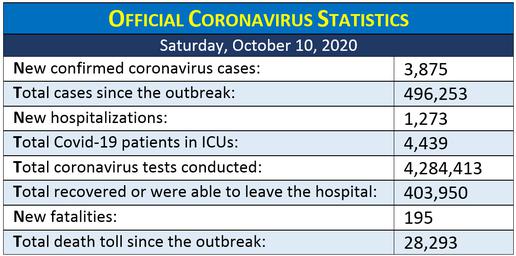
Dr. Lari also reported that, out of the 31 Iranian provinces currently 30 provinces are in a high state of alert.

October 12:
The daily death toll from coronavirus broke records in Iran for a second day in a row, with 272 fatalities on Monday, October 12, up from 251 a day earlier. The majority of hospitals have run out of beds and the surge of coronavirus is so overwhelming that the National Coronavirus Taskforce finally approved a measure to impose fines on “coronavirus violators” in greater Tehran, saying that other provinces might follow suit.
According to Dr. Masoud Mardani, an infectious diseases specialist and a member of the National Coronavirus Taskforce’s Scientific Committee, the dimensions of the recent surge in coronavirus are very alarming. “In the last seven or eight months we have never come across such a situation,” he said. “If this trend continues we can expect a significant rise in the number of hospitalizations and mortalities.” He said some hospitals in Tehran have been almost filled to capacity.
General distribution of the flu vaccine was supposed to start in August, but this has yet to happen. Health officials had promised to provide 16 million doses but so far, they have secured only 1.7 million doses for exclusive use by high-risk groups.
Meanwhile, health minister Saeed Namaki announced on October 12: “In the next two or three weeks the testing of the vaccine on humans will start.” He was of course not referring to the flu vaccine but to a vaccine for coronavirus being developed in Iran. Namaki claimed the results from tests on animals had been encouraging but that there were still unanswered questions about its degree of effectiveness, durability and other features. “We are working on these,” he said.
In Tehran province, only 32 percent of people are observing health protocols, according to Hamid Reza Goodarzi, deputy governor for security affairs in the province. He stated that wearing masks is mandatory for people over 18. The first time an individual violates the mandate, they will receive a warning, he said, but if they break the rules a second time they will be fined 50,000 tomans ($12).
Air pollution in metropolitan areas threatens to weaken the body’s defenses against coronavirus, said Dr. Abbas Shahsavani, head of the health ministry’s Working Group on Air Safety and Climate Change. “Published research shows that long-term exposure to suspended particles and polluting gases such as nitrogen dioxide results in the overproduction of ACE2 [angiotensin-converting enzyme 2] in the lungs’ alveoli [air sacs] and this…disrupts the body’s defense system.”
Pointing out that with the arrival of cold season, air pollution will increase, he asked people to stay indoors for longer periods on days when air pollution is high.
Provinces Round-up
On October 10, the spokeswoman for the health ministry said that over the last week the average number of fatalities from coronavirus across Iran had been 20.2 per one million of the population, though in certain provinces such as Qom the number is much higher than the national average.
According to statistics published by Qom University of Medical Sciences, 233 patients in the province lost their lives to Covid-19 in the last three weeks, and the death toll over that period showed an increase when compared to the week before. According to these statistics, each day more than 100 patients are hospitalized in the province, which does not have a high population. During the second week of October, 1,253 Covid-19 patients were hospitalized in Qom, compared to 1,162 a week earlier.
On Wednesday, October 14, new coronavirus restrictions will be imposed in Fars province for 10 days, reported Abdolreza Ghasempour, acting governor of Fars. These restrictions will be introduced despite the fact that the health ministry had stated that the situation in the province was better than average. According to Ghasempour, reception halls, coffee shops and cafés will be closed and restaurants, fast food outlets, fruit juice and ice cream bars will only be allowed to offer take-out services.
Since the coronavirus outbreak, 25 medical staff in the northern province of Gilan have lost their lives to Covid-19, according to Abtin Heydarzadeh, vice president of Gilan University of Medical Sciences. He said that, over the last 24 hours, more than 50 new coronavirus patients had been hospitalized in the province, bringing the total to more than 350.
The situation in the neighboring province of Mazandaran had not changed much throughout the first weeks of October. As of October 12, 528 coronavirus patients were hospitalized across the province.
However, the situation in the neighboring provinces of Tehran and Alborz continues to be critical. In the 24-hour period spanning October 11 and October 12, 18 Covid-19 patients died in Alborz, according to Mohammad Fathi, president of Alborz University of Medical Sciences. In the same 24 hours, 137 new coronavirus patients were hospitalized in the province, bringing the total number of current hospitalizations to 745.
In her daily briefing for October 12, the health ministry spokeswoman Dr. Sima Sadat Lari announced the official coronavirus statistics for the last 24 hours.
October 16:
A Weekly Review of Coronavirus Disinformation in Iran: A Public Health Show
It has been eight months since the coronavirus epidemic in Iran began. Initially, the government concealed the coronavirus outbreak in Iran in the run up to parliamentary elections in February, and since then most people believe that official statistics about the scope of the epidemic have not been forthright or honest. Throughout this eight-month period, Iranian officials have consistently made contradictory statements, and as the number of daily coronavirus deaths exceeds 250, their contradictory statements have increased as well.
With this, rumors, fake news and superstitions have proliferated, and, with the deluge of misinformation and the lack of trust in government, a large segment of the population are confused about how to handle the situation.
Over the last two weeks three plans that had been approved by the National Coronavirus Taskforce were implemented. It started with the lockdown of some businesses in Tehran and continued with the mandatory wearing of masks in Tehran beginning on October 10. Then a religious holiday presented a long weekend and traveling to and from five metropolitan areas — Tehran, Karaj, Mashhad, Isfahan and Urmia — was banned from Thursday, October 15, until midday on Sunday, October 18.
If these plans had been implemented correctly, they could have been effective in reducing transmission of the virus, as officials had claimed. However, evidence suggests the plans amounted to little more that a political show.
On October 15, five days after wearing masks became mandatory and violators were threatened with heavy fines, General Teymour Hosseini, commander of the Traffic Police, reported that nobody had been fined for not wearing a mask. He also reported that police surveillance cameras will not be used to identify violators, contrary to previous announcements. People will be fined in person, he said.
Deputy Health Minister Ali Reza Raeesi had previously announced that pedestrians not wearing masks would be identified by police cameras and would be fined. “This is exactly like when people do not use safety belts while driving,” he said. “Police camera will identify them. The same system that is used to identify people with bad hijab will be used here as well.”
The idea of controlling infected people by tracing their cellphone signals has been repeatedly raised by officials on Iranian television. However, the statements appear to be an attempt to frighten people into observing health guidelines and authorities do not seem to have a real plan, or even the capability, to follow this course of action.
Even the quarantine of five metropolitan areas has remained mostly just an idea in principle. According to information published about the traffic in and out of these cities, no authority or agency has seriously tried to enforce the quarantine. Furthermore, photographs posted on social media suggest the plan was only implemented on paper, not in practice.
On October 13, Ali Rabiei, a government spokesman, reported that every day 10,000 more coronavirus tests are being conducted across the country.
In her daily briefings, Dr. Sima Sadat Lari, the health ministry spokeswoman, announced the number of coronavirus tests conducted since the outbreak. According to her, as of October 16, the number of tests conducted in Iran stood at 4,454,570. Considering this number and comparing it to previous statistics, it appears that, on average, between 27,000 and 29,000 tests are conducted each day across the country. If what Ali Rabiei said was true, this number should have reached to between 37,000 and 39,000 per day and, in recent days, between 47,000 and 49,000. But the figures reported by Dr. Lari show that the number of tests per day still stands somewhere between 27,000 and 29,000, of which more than 4,000 have been positive.
Therefore, either the government’s spokesman had been misinformed, or he simply wanted to announce an impressive number. What is certain, however, is that as of October 16, the promise to conduct more than 10,000 tests per day has not been fulfilled.
Since summer, many people have been worried about the arrival of the cold season and the dangers of having to deal with coronavirus and influenza at the same time. A search for “flu vaccine” on the website of one of the Iranian official news agencies uncovers a range of contradictory statements by officials of the health and interior ministries – and even by doctors – about the supply of a flu vaccine.
Across the northern hemisphere, the best time to be vaccinated for flu is early to mid-September. But in Iran the “best time” depends on the changing promises of officials. At first it was promised that two million doses of flu vaccine would imported in mid-July and would be made available to the public. It was even claimed that in September and October one million doses would be produced within Iran.
Then reports started to trickle out that the distribution of the vaccine had been postponed until early September and would be made available only to high-risk groups such as the elderly and pregnant women. On September 1, Ali Rabiei, the government’s spokesman, reported that seven million doses of flu vaccine had been ordered from European countries.
Things continued in this manner and officials postponed the distribution of vaccine first to mid-September and then to late September. Nevertheless, Kianoush Jahanpour, speaking for the Food and Drug Administration, promised that 12 million doses of flu vaccine will be imported.
Then some started saying that not everybody needs to be vaccinated against flu. Even Iranian media published articles arguing that flu vaccination is not a necessity for everybody.
Nevertheless, on September 12 Abdolhossein Rouholamini, a member of parliament’s health committee, dismissed concerns about the supply of flu vaccine and said that “considering the coronavirus epidemic and the increased demand for flu vaccine a large number of doses has been procured.”
In late September it was announced that 1.5 million doses for high-risk groups had been distributed to medical workers. But after more than two weeks, some provinces had yet to receive their quotas. Then news broke that the health ministry had given preferential treatment to members of parliament by providing them with 1,500 doses of vaccine that were supposed to be used for vaccinating high-risk groups. A parliament spokesman announced that it would return the vaccine but the damage to the credibility of the health ministry was done.
The main reason behind all these contradictory statements – and we have not been able to mention all or even most of them in this report – is Iran’s disrupted relations with the international banking system due to American sanctions. Reportedly, a bank in Turkey has been unable to transfer Iranian funds to manufacturers of flu vaccine in Europe, despite claims that medical items and vaccines are exempt from sanctions.
In any case, as of now the Iranian government has not provided high-risk groups with all the doses that had been promised. What is interesting is that even now, with the shortage of vaccines, no government official is talking about made-in-Iran flu vaccines.
In her daily briefing for October 16, health ministry spokeswoman Dr. Sima Sadat Lari announced the official coronavirus statistics for the past 24 hours:
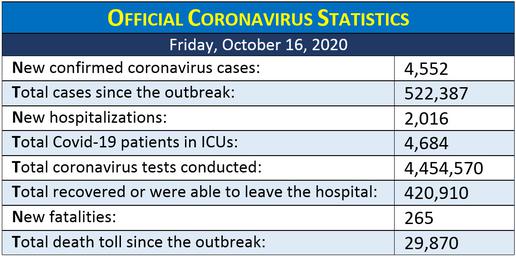
Dr. Lari also reported that of the 31 Iranian provinces currently 30 provinces are still in a high state of alert:

October 17:
With 253 new deaths, Iran’s coronavirus death toll passes 30,000
According to official figures, Covid-19 has killed over 250 people in Iran each day in recent days and, with 253 new deaths in the past 24 hours, the official death toll has now passed 30,000 people.
To slow down the spread of the virus, the government quarantined five major metropolitan areas for the long weekend that includes a day of mourning for the passing of the Prophet Mohammed and for the martyrdom of his grandson Imam Hassan, the second Shia Imam. But neither the people nor the agencies responsible for enforcing quarantines took this measure seriously. Many left the quarantined cities to travel and in many cities, including Mashhad, public mourning ceremonies with large gatherings of people were held. What became clear was that the government, as represented by the National Coronavirus Taskforce, lacks the power or credibility to implement its decisions.
The lack of success in carrying out measures such as mandating masks in Tehran and banning travel to and from the five quarantined cities has convinced the government that it needs to implement stricter measures. On October 17, First Deputy Health Minister Iraj Harirchi talked about imposing more exacting restrictions in Tehran and 45 other cities with high levels of coronavirus infections.
With the rapid increase in the number of coronavirus cases and fatalities, Iran’s Supreme Leader Ayatollah Ali Khamenei has allowed the military to add their facilities and manpower to the fight against the pandemic. According to Hasan Araghizadeh, head of the General Staff of the Armed Forces Health Department, the military is ready to set up field hospitals for victims of the virus.
This offer was not enthusiastically received by Health Minister Saeed Namaki. “Nowhere in the world are field hospitals used as long as there are regular hospitals,” he said, only a few minutes after the announcement by the military.
But reports from across Iran indicate that “regular hospitals” are running out of beds. A few days ago Anooshirvan Mohseni Bandpey, governor of Tehran province, reported that of the 14,000 beds at government hospitals in the province, 5,000 of them are occupied by Covid-19 patients.
Besides a shortage of hospital beds, obtaining necessary medications for Covid-19 patients has become problematic as well. Hospitals say that they do not have enough medication and the prices on the open market are extremely high. Nevertheless, Mohammad Reza Shanehsaz, head of the Food and Drug Administration, claimed that Iran produces enough coronavirus medication and even exports some of its medicinal stock.
He denied that there are shortages of Remdesivir, Favipiravir and Actemra, the most effective drugs so far for treating Covid-19, and speculated that hospitals cannot procure them because of financial difficulties and because they owe money to the companies that sell them.
With the arrival of the cold season, and worsening air pollution, there are concerns that respiratory diseases are bound to increase, especially in Tehran.
Tehran’s air is going to be more polluted than previous years, warned Mohammad Mehdi Mirzaei Qomi, head of Iran’s Environmental Protection Agency Climate Change Center. “Since health protocols promote the use of private means of transportation and the health ministry’s advice to people is not to use public transportation, we shall witness more air pollution this year than previous years,” he said. “Unfortunately, air pollution directly affects the situation with coronavirus. An increase of one unit of suspended particles in the air leads to an eight percent increase in Covid-19 fatalities.”
Provinces Round-up
With the rate of infections showing no sign of abating, Anooshirvan Mohseni Bandpey announced that restrictions imposed recently have been extended.
“All restrictions announced last week will remain in place in Tehran province from Sunday, October 18, for another week,” he said. “Our emphasis is that schools, universities and other educational institutions hold their classes not in person but remotely,” the Tehran province governor said.
He also announced that many educational, religious and leisure centers in Tehran will remain closed and pointed out that people must be wearing masks the moment that they leave their homes.
In the past 24 hours, 80 new Covid-19 patients have been hospitalized in Gilan province, reported Abtin Heydarzadeh, vice president of Gilan University of Medical Sciences. “This number is unprecedented,” he said. According to him, currently 350 Covid-19 patients are hospitalized in the province.
Coronavirus restrictions in Qazvin province have been extended for the third straight week, announced Manouchehr Habibi, director of the Qazvin Coronavirus Taskforce. “All schools, universities, educational institutions and vocational, technical and driving schools will be closed in the coming week and must do whatever they can remotely,” he said. “Religious, cultural and social gatherings are banned as in the two previous weeks.”
In her daily briefing for October 17, health ministry’s spokeswoman Dr. Sima Sadat Lari announced the official coronavirus statistics for the past 24 hours:
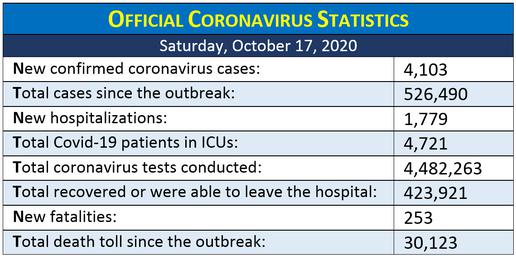
Dr. Lari also reported that of the 31 Iranian provinces currently 30 provinces are still in a high state of alert:
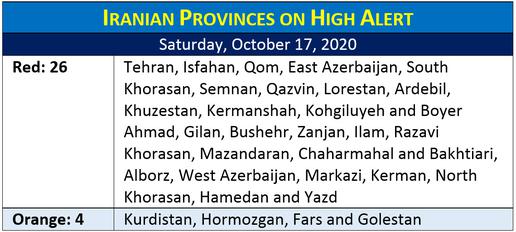
October 20:
Iran’s health minister Saeed Namaki has said that Iran is descending into a “dark pit” and expressed profound anxiety as Iran experienced a conspicuous spike of coronavirus fatalities in recent days. Pointing to the daily statistics regarding cases and fatalities, he said: “Everyone should know that I, as health minister, cannot bring this epidemic situation under control alone. A lot more is required.”
He insisted that businesses were not doing enough to make work and public environments safe, despite guidelines set out by the government and a significant amount of “begging” from officials. He pointed in particular to the travel industry, saying airlines were not doing enough, and warning of the dangers posed by public transport. “Which buses comply with health protocols? They said that by late May they would add more buses but they have not added even one.”
He also hinted at tensions between the health ministry and the taskforce established to handle the coronavirus crisis, and suggested police needed to improve their efforts too. “We asked the National Coronavirus Taskforce to fine anybody who does not wear a mask, but look at the statistics and see how many people have been fined. We said close the roads but how many did they close? This is no way to contain the pandemic."
General Hossein Rahimi, Tehran’s police commander, said that, at the moment, the police have only been warning pedestrians who do not wear a mask in a way that “guides” them, not in a manner that suggests punishment. He said police would fine drivers and passengers when the time comes, after the policy of fining people was officially announced.
Namaki also said religious holidays in September and October mourning the martyrdom of Imam Hossein had had a significant impact on Iran’s coronavirus crisis. “It is really painful to see that a hospital is overflowing with patients, but 100 meters away people have gathered [to mourn] and nobody comes to disperse them.”
What are the Real Figures?
Several health officials have challenged the daily statistics announced by the government, and demanded to know how much they actually reflected the dire situation on the ground.
Among them is Dr. Masoud Mardani, a specialist in contagious diseases and a member of the National Coronavirus Taskforce’s Scientific Committee, who said, “The daily death toll from coronavirus has reached 337, but this is not the real number. To find how many really die in a day we must multiply this number by 2.5.
“The hospitals are overflowing with patients and have no empty beds,” he said. “Considering the upcoming holidays we are more worried than ever.” He proposed that people who travel out of their towns of residence via car be fined a million tomans ($240) and that the money generated from fines be spent on preventing and treating Covid-19.
If Mardani’s assessment is correct, it would mean there were around 850 deaths in just the last 24 hours. If this is true, Namaki’s anxiety would be completely understandable, although despite his worries, the minister swore to God that the figures the Islamic Republic has announced are “among the most accurate statistics in the world,” adding that “they can all be defended and they are based on the most updated evidence.”
On October 20, an Iranian company claimed it was in the process of developing a coronavirus vaccine based on a measles vaccine, announcing that it will cost between $6 and $10. The company did not, however, say when this vaccine would be made available.
Despite such widespread confusion and disagreements among government and health officials, Saeed Namaki corroborated claims that an Iranian-manufactured coronavirus vaccine was approaching an advanced testing stage and was almost ready to be trialed on humans. “The Iranian vaccines has passed animal testing and human testing will start in the first half of November,” he said. “Four or five teams in Iran are going through testing phases. Two or three of these groups have made good progress and have performed the necessary tasks required by international standards.”
Provinces Round-up
In recent days there have been reports that Tehran’s Masih Daneshvari Hospital has run out of beds and long lines of patients have formed at its emergency ward. On October 20 the hospital announced that it had set up a new emergency ward and treatment center specifically for Covid-19 patients.
On October 20, Alborz province, a coronavirus hotspot, broke its record for Covid-19 fatalities. In the 24-hour period between October 19 and October 20, 27 more coronavirus patients died, bringing the total death toll for the province to 1,472, according to Dr. Mohammad Fathi, president of Alborz University of Medical Sciences. Emphasizing that the province has been in a critical condition since the week before this recent announcement, he said, “Currently 775 coronavirus patients are hospitalized in the province and, in the last 24 hours, 131 of them have been moved to the ICU.”
In the last 48 hours, 40 people died from coronavirus in Markazi province and 523 new cases were confirmed, bringing the total number of cases in the province since the pandemic started to 20,192, reported Dr. Mohammad Jamalian, president of Arak University of Medical Sciences. Of the new cases, he said, 82 have been hospitalized and the rest had been quarantined at home until they tested negative. According to him, the total death toll in Arak, the capital of Markazi province, currently stands at 734.
In her daily briefing for October 20, the health ministry spokeswoman Dr. Sima Sadat Lari announced the official coronavirus statistics for the last 24 hours:
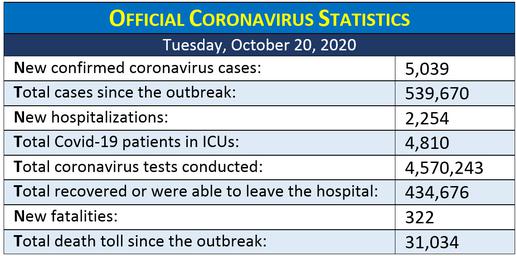
Dr. Lari also reported that out of the 31 Iranian provinces, currently 30 provinces are still in a high state of alert:
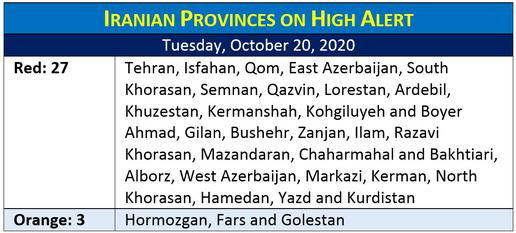
This is part of IranWire's coronavirus chronology. Read the full chronology
October 21:
The coronavirus crisis in Iran has now engulfed the whole country, including small towns and rural regions. Everywhere has been hard hit by the pandemic. Hospitals are running out of beds, or already have. Infections within families are on the rise, with entire households having to be hospitalized. As patients arrive at hospitals, many of them have to wait for beds to become available. According to official statistics, an average of more than 300 coronavirus patients have died each day over the last few days.
In Iran’s capital the crisis is getting worse every day. Dr. Alireza Zali, director of the Tehran Coronavirus Taskforce, reported that health workers are exhausted and Tehran is facing a shortage of medical manpower. He also reported that police officers have begun stepping in to enforce the greater restrictions. However, despite the fact that the taskforce approved lockdowns and fines for people who violate regulations to tackle the spread of coronavirus more than three weeks ago, little has been done to enforce these decisions. Even government agencies have refused to enforce them, opting for “guiding” people by issuing warnings.
“In other countries, when a person tests positive for coronavirus he is kept under surveillance so that he will not break quarantine, but here he is released immediately after he is tested positive,” said Dr. Mostafa Ghanei, chairman of the National Coronavirus Taskforce’s Scientific Committee, in a TV interview.
The public has tended to ignore the restrictions announced by the National Coronavirus Taskforce and the Rouhani administration. In mid-October it was announced that during the three-day holiday weekend five metropolitan areas, including Tehran, would be quarantined and travelers would not be allowed to leave or enter these metropolitan areas but, in practice, the measure was not enforced and it contributed little to reducing the number of travelers. Judging by statements issued by some officials, this behavior was expected.
“We have always advised against holiday traveling under these difficult conditions and, God willing, we will have a plan for next week,” said Mahmoud Vaezi, a government spokesman. The plan was due to be discussed on October 22 and October 23 as part of meetings between President Rouhani and various committees of the National Coronavirus Taskforce.
Provinces Round-up
According to Dr. Ali Maher, a deputy director of Tehran Coronavirus Taskforce, more people in Tehran are being admitted to the hospitals than are released. “There can be no doubt that Tehran is going to face a serious problem in hospitalizing new coronavirus patients,” he said. “Of course, setting up field hospitals is not [yet] on the taskforce’s agenda, but such hospitals could be used if the need arises and the situation becomes more critical.”
In recent days some health experts have said that the actual number of coronavirus fatalities is at least two times higher than the official figures. “That is what is happening in Isfahan, and our statistics about coronavirus deaths are among the most accurate in the country, whereas many provinces only announce fatality figures for patients who have tested positive,” said Behrouz Kalidari, vice president of Isfahan University of Medical Sciences. “From the very beginning we tried to register and announce figures that include patients whom the doctors have diagnosed as suspected cases even if their PCR [polymerase chain reaction] tests have returned negative.”
Based on these figures, since the epidemic started, more than 42,000 coronavirus patients have been hospitalized in Isfahan and approximately 4,600 have died. In the 24-hour period spanning October 20 and October 21, approximately 300 new Covid-19 patients were hospitalized in Isfahan, the same as the average daily number for the last three weeks. “Every day we lose an average of 35 patients — 18 if we only count those who have tested positive,” said Kalidari. “Last week, however, this figure reached 40.”
Coronavirus infections in the cities of Abadan, Khorramshahr, and Shadegan in Khuzestan province are on the rise, and the ICU ward at Abadan Hospital is full, according to Dr. Shokrollah Salmanzadeh, president of Abadan University of Medical Sciences. “It has no beds left for treating Covid-19 patients in a critical condition. “Only if a patient who has been in critical condition recovers will we be able to provide an ICU bed for another patient.”
In her daily briefing for October 21, the health ministry spokeswoman Dr. Sima Sadat Lari announced the official coronavirus statistics for the last 24 hours:

Dr. Lari also reported that out of the 31 Iranian provinces, currently 30 provinces are still in a high state of alert:
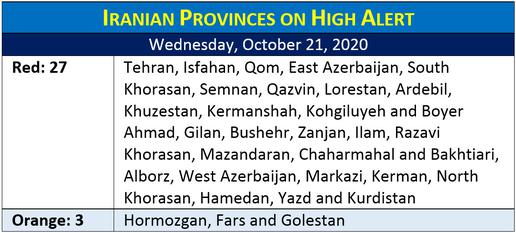
October 22: Ayatollah Khamenei Announces Fatwa on Coronavirus Eight Months Into the Crisis
On October 22, eight months into the crisis, Ayatollah Khamenei issued a fatwa regarding coronavirus, reiterating the basic rules for how to deal with the pandemic. When asked what duties an individual had when dealing with coronavirus, he said If someone knows they are infected and that they might transmit the virus, they must avoid contact with others. Going to places where there might be a possibility of infection must be avoided unless health guidelines are followed, he said. He provided no further details or guidance.
On the same day, the heads of the National Coronavirus Taskforce’s committees met with President Rouhani, who chaired the meeting. New orders were set out to cope with the deteriorating situation, including restrictions in 43 cities across Iran. “Performing extensive, targeted and smart testing must be the priority of the Treatment Committee,” Rouhani said at the meeting. He called for the “smart” tracing of coronavirus patients during the required period of quarantine and announced that 50 percent of government employees could work remotely for the next month.
However, the National Coronavirus Taskforce has approved similar guidelines and restrictions in a more limited extent in recent weeks. So far, these measures have not had the intended impact and have not helped drive down the number of coronavirus cases in the country. The public has ignored government restrictions, and the government has not done much to enforce them.
The daily death toll from Covid-19 was over 300, continuing the trend in recent days and bringing the official death toll since the pandemic started to 31,650. However, according to a number of health experts, the actual figure for fatalities is at least double that.
After eight months of fighting the pandemic, health ministry officials concede that health workers are “exhausted and worn out.” Not only have they been working non-stop, many of them have not been paid, partially because money that was supposed to be allocated to deal with the coronavirus crisis has failed to materialize. Meanwhile, Covid-19 mortality and infection rates among medical staff have also contributed to the severe shortage of medical manpower in hospitals.
“Half of the health workers and medical staff at hospitals are suffering from psychological problems,” said Jalil Kouhpayeh, president of Iran University of Medical Sciences. “Unlike physical disorders, psychological problems do not have specific causes. Rather, they originate from issues that, after a long period of time, wear out the mind. In this case, the psychological problems of most health workers and medical staff at hospitals are caused by their non-stop work in coronavirus wards.”
Provinces Round-up
Ali Akbar Ashouri, director of management for the Ministry of Roads, predicted that traffic would be very heavy on the highways between Tehran province and the scenic northern provinces from Thursday, October 23 until the evening of Sunday, October 25.
The number of coronavirus infections in Rasht, the capital of Gilan province, has doubled, according to Governor Ali Fathollahi, who said that visitors were continuing to travel to the province, making the situation worse. He also reported that parks and recreation areas in the city had been closed down.
In the 24-hour period spanning October 21 and October 22, 211 new coronavirus patients were hospitalized in Kermanshah province, bringing the total number of hospitalized cases to 778, announced Mehdi Mohammadi, head of Kermanshah University of Medical Sciences’ Coronavirus Information Committee.
Alborz province is still in a red state of alert, infections are on the rise and, therefore, restrictions in the province have been extended for an additional week, from October 24 to October 30, reported Ali Darvishpour, acting director of Alborz Coronavirus Taskforce.
Similarly, officials in West Azerbaijan province have also extended restrictions for another week. The restrictions were initially imposed at the beginning of October.
In most provinces that have imposed restrictions, universities, schools, student dormitories, seminaries, technical and vocational schools, childcare centers, libraries, museums, indoor swimming pools, cinemas, theaters and parks have been shut down. Added to this has been the closure of reception halls, beauty salons, mosques and prayer centers, coffee shops, zoos, and gyms. Contact sports such as wrestling, karate and judo have been banned, as have social, cultural, and religious ceremonies and gatherings and Friday prayers.
In her daily briefing for October 22, the health ministry spokeswoman Dr. Sima Sadat Lari announced the official coronavirus statistics for the last 24 hours:
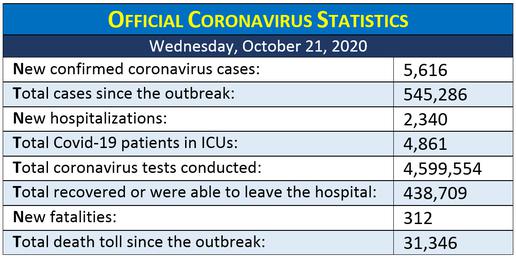
Dr. Lari also reported that out of the 31 Iranian provinces, currently 30 provinces are still in a high state of alert:

October 26: Revolutionary Guards Launch “Jihad” Against Coronavirus
The crisis unleashed in Iran by the surge of coronavirus in recent weeks has forced government officials to be more forthright with the public. In late October, the average number of Covid-19 fatalities was over 300 per day, but a number of health officials have said the true number can only be determined by multiplying that figure by somewhere between two and four.
The deteriorating situation has also forced the government to increase restrictions and order more businesses to shut down, at least for a week. The newfound transparency from officials is a hopeful sign but this apparent honesty has also served to shift responsibility on to the public. Essentially, the government has announced that people must take precautions themselves and that it cannot be responsible if they contract the virus.
The coronavirus crisis is so bad that the Supreme Leader Ali Khamenei has called for the mobilization of “jihadi forces and the mosques,” urging them to do their part.
“Patients in Tehran who go to treatment centers are in the most critical condition,” reported Dr. Alireza Zali, director of the Tehran Coronavirus Taskforce. He said a list of patients who have been released from the hospital after testing positive will be given to “social institutions” and “neighborhood Basiji members” so that they can surveil these patients during house quarantine.
“To plan accurately and carry out the necessary interventions, a detailed record of infections, deaths and releases from the hospital for each neighborhood at the end of the week is required,” announced Dr. Zali.
With these statements, the Revolutionary Guards and the paramilitary Basij have officially been brought in to fight the coronavirus crisis.
General Mohammad Reza Yazdi, commander of the Revolutionary Guards in Tehran, reported that “jihadi groups” are preparing to follow the Supreme Leader’s command by “identifying individuals who transmit the disease,” “helping to disinfect public places and public transportation vehicles,” “distributing free or inexpensive masks,” “conducting patrols to forbid violations of health protocols,” “distributing food items among patients and medical staff,” “supplying smart help to vulnerable groups,” and so on.
The two coinciding issues of air pollution and coronavirus have caused serious lung problems and the situation is even worse for individuals suffering from underlying diseases, said Mahmoud Mir-Lohi, a member of Tehran City Council. He reported that the number of coronavirus fatalities in Tehran is now between 150 and 160 per day, “15 to 20 times higher than in May, when the daily number of fatalities was at most nine. Some experts believe that one reason for this increase is air pollution.” He added that he believes the only way to cope with the epidemic and pollution is to remain at home and avoid traveling.
As of October 26, out of 21 members of Tehran City Council, five have been infected with coronavirus — Zahra Sadr-Azam Nouri, Ali E'ta, Mohammad Alikhani, Zahra Nejad-Bahram and, most recently, Majid Farahani.
Provinces Round-up
Based on decisions approved by the National Coronavirus Taskforce, all non-essential businesses in 43 cities in the red state of alert were due to close starting on Monday, October 26, announced government spokesman Ali Rabiei. “Violations of these shutdowns will result in heavy fines and long-term closures,” he warned.
In East Azerbaijan, 17 Covid-19 patients had died between October 25 and October 26, reported Dr. Mohammad Hossein Sumi, president of Tabriz University of Medical Sciences. He said in the same time period, a new record was broken regarding hospitalizations in the province. In the last 24 hours, 294 new coronavirus patients were hospitalized in East Azerbaijan, the highest number in the last eight months. As of October 26, a total of 1,298 people were hospitalized across the province. He also reported that 10 “prominent and active” doctors were among them after becoming infected with coronavirus.
No flu vaccine has been made available to pharmacies in Alborz province, said Mehrdad Babaei, a spokesman for Alborz University of Medical Sciences. According to him, currently 810 Covid-19 patients are hospitalized across the province and, with the death of 17 patients in the last 24 hours, the total death toll in Alborz rose to 1,858.
For the last two months health ministry officials have promised that “enough” flu vaccines would be distributed “soon” but, as of October 26, these promises remained unfulfilled.
Iran’s Latest Coronavirus Statistics
In her daily briefing for October 26, the health ministry spokeswoman Dr. Sima Sadat Lari announced the official coronavirus statistics for the last 24 hours:
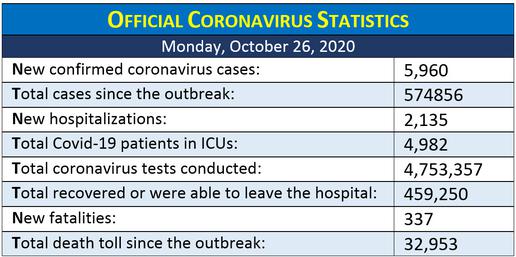
Dr. Lari also reported that all 31 Iranian provinces are in red, orange or yellow states of alert.
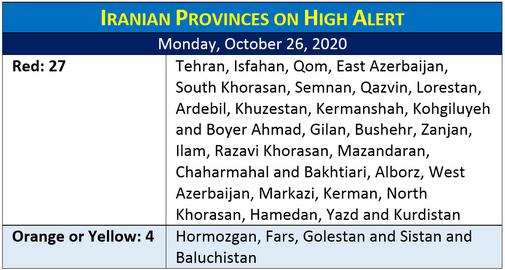
October 27:
Religious Ceremonies Break New Coronavirus Rules
How many people in Iran have really been infected with coronavirus or are likely to be infected in the future? Statistics released by the health ministry do not tally with field reports from provinces and the hospitals. People are confounded by contradictory information they receive about the pandemic: the number of cases and fatalities, the availability of beds in hospitals, the availability of medication, the situation regarding flu and coronavirus vaccines, the effects of air pollution and the colder weather on the pandemic, unclear decisions and guidelines, conflicting statements and assertions by officials and the media, and so on.
It is no surprise, then, that many people have been ignoring the guidelines approved by the coronavirus taskforce, including the temporary closure of businesses, wearing masks and avoiding travel. What is worse is that often the government itself does not take these decisions and guidelines seriously, and puts little effort into enforcing them.
On Saturday, October 24, Ayatollah Khamenei and President Rouhani attended a National Coronavirus Taskforce meeting, where it was decided that further restrictions were to be imposed in 43 cities in a red state of alert, and a range of businesses were to be closed down for at least a week. Later, the Supreme Leader called on “jihadi” forces of the paramilitary Basij and mosques to take an active and key role in coronavirus crisis management.
However, there are already signs that the new round of restrictions might meet the same fate as previous ones. On October 27, the great stadium of the holy city of Mashhad, which is currently experiencing one of its worst weeks since the beginning of the coronavirus outbreak, hosted the “Allegiance Jubilee,” a ceremony to renew allegiance to the Hidden Imam, the messiah that Shias believe will emerge from hiding and establish peace and justice.
Denying the claim by a speaker at the ceremonies who said he had received a permit for the gathering, Kianoush Jahanpour, head of the health ministry’s information center, tweeted: “neither the health ministry nor the Mashhad University of Medical University has issued a permit to a group or an individual to hold a gathering or a public ceremony called ‘allegiance’ or anything else, especially only 48 hours after directives for fighting coronavirus were issued by the exalted Supreme Leader.”
“I can only say that I am sorry,” said Dr. Minoo Moharez from the National Coronavirus Taskforce’s Scientific Committee. “Those who held such a gathering in Mashhad are responsible and must be held accountable.” She failed to suggest any action for holding the organizers “accountable.”
The health ministry’s spokeswoman Dr. Sima Sadat Lari called the holding of these ceremonies “a crime.” “This event caught us off guard,” she said. “We tried hard to find out who had issued the permit but nobody knew anything about it. In this situation, when we are all wanting more restrictions to control the contagion, this is a crime.”
News reports continue to present contradictory figures for coronavirus infections and fatalities. Some health officials say that official numbers must be doubled or even quadrupled to understand the depth of the coronavirus crisis in Iran.
On October 27, Dr. Reza Malekzadeh, deputy health minister for research and technology, added a new figure to the mix. According to studies, he claimed, by the end of September, approximately 35 million Iranians had been infected with coronavirus. “These 35 million are immune because they have had coronavirus, meaning that they no longer need a vaccine. But we must be aware that around 50 million Iranians are still at risk because they have not been infected with this disease.”
On July 18, President Rouhani had presented similar, if lower, precursor numbers. At a meeting of the National Coronavirus Taskforce, referring to a report that he had received from the health ministry, Rouhani said that 25 million Iranians had “left coronavirus behind,” and that between 30 and 35 million people were in danger of infection in the coming months. At the time, this statement sparked a controversy and at least one health official suggested he had misunderstood the report.
Daily statistics regarding infections and fatalities show that Iran is at the height of the epidemic, said Dr. Payam Tabarsi, head of the infectious diseases ward at Tehran’s Masih Daneshvari Hospital. “Our main problem is that people have resumed their travels, and also parties and weddings have resumed.”
He paid lip service to the role played by the Supreme Leader in fighting coronavirus but then dismissed new restrictions imposed in 43 cities as ineffective and not very different from previous ones. “We are not going to get the desirable outcome with these restrictions,” he said. “To reduce infections we need a shutdown of two or three weeks, and the reopenings must take place little by little and carefully.”
News From Gilan and West Azerbaijan
In the 24-hour period spanning October 26 and October 27, 304 new coronavirus patients were hospitalized in West Azerbaijan province, reported Dr. Javad Aghazadeh, president of West Azerbaijan University of Medical Sciences. “The number of hospitalized patients with acute pulmonary syndrome now stands at 1,427,” he said. “Two hundred and sixty-nine of them are in ICUs and 74 are connected to ventilators.” This number of new hospitalizations in just one day is alarming because only a daily average of 1,500 coronavirus tests are conducted in this province.
Seven students from Gilan University of Medical Sciences with coronavirus symptoms have been tested and are waiting for their test results, reported Fardin Mehrabian, the university’s vice president. Prior to this, 18 students at the university had been infected and currently two medical interns are hospitalized.
Iran’s Latest Coronavirus Statistics
In her daily briefing for October 27, the health ministry spokeswoman Dr. Sima Sadat Lari announced the official coronavirus statistics for the last 24 hours:

Dr. Lari also reported that all 31 Iranian provinces are in red, orange or yellow states of alert.
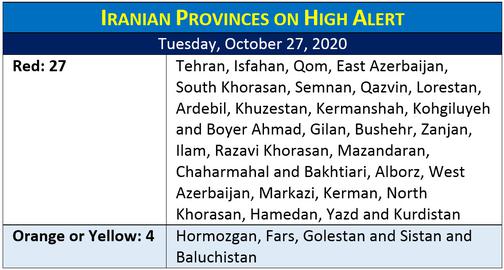
October 28:
One Iranian Dies From Covid-19 Every Four Minutes
On Wednesday, October 28 the death toll from Covid-19 in Iran rose to 415 in 24 hours, once again breaking the daily record. This means that since Tuesday, one Iranian has died from Covid-19 every four minutes.
Tehran has borne the worst of these fatalities, with more than half of the most recent deaths recorded in the capital. According to Dr. Alireza Zali, director of Tehran’s Coronavirus Taskforce, the number of both inpatient and outpatient cases of Covid-19 in Tehran is rising like a tidal wave. On the assumption – as health officials have suggested – that the true death toll is likely to be two and a half times higher than the official figure, Dr. Zali said Tehran is facing a “disaster”.
Despite this, Tehran is exempt from the list of 43 Iranian cities on a near-total lockdown. “Because of the complexity of the situation in Tehran,” Dr. Zali said, “the indicators that must be used to declare the city in crisis are different from those that apply to the provinces. The reasoning was that… infection rates must get higher in Tehran [before the same restrictions can be imposed].”
The reason for the absence of a lockdown in Tehran, according to Mohsen Hashemi Rafsanjani, the president of Tehran City Council, is the economy and not health considerations. “The government has given the difficult economic situation priority over people’s health,” he said. “If the economic conditions were better the government would have taken better care of people.”
Even Health Minister Saeed Namaki hinted at something similar. “Everywhere in the world,” he said, “it’s the economy that supports the health sector during an epidemic. But in Iran we are supporting the economy during sanctions. The livelihood of a kiosk owner comes entirely from his kiosk and we cannot keep it closed eternity. We have written protocols for all businesses, and we have paid the price as well.”
Reshuffle at Coronavirus Taskforce
In a probably attempt to mitigate the damage done by health officials’ contradictory statements and statistics about coronavirus in Iran to date, President Rouhani has appointed Alireza Raeesi as the new spokesman for the National Coronavirus Taskforce. “From this date on,” he said, “the only reliable and authoritative source for plans and decisions by the taskforce shall be the spokesman.”
By order of Supreme Leader Ali Khamenei, a “base of operations” for the National Coronavirus Taskforce has also been created and interior minister Abdolreza Rahmani Yazdi has been appointed as its first commander. The use of the term “base” has led many to believe the epidemic is now being considered a security issue first, not a matter of public health.
The Waiting Game for a Vaccine
A coronavirus vaccine developed in Iran will be available in early spring, Saeed Namaki has promised. The health minister made the claim despite the fact that all previously-announced “Iranian-made vaccines” have been postponed time and again. Currently, it is not even clear when the regular flu vaccine imports Iran promised in the summer will begin to materialize. Nevertheless, Namaki insisted that a home-grown coronavirus vaccine would enter the human testing phase in the next week.
Namaki also announced that as of now, the health ministry has received around half of a billion-euro subsidy from the National Development Fund, allocated to help the country fight against coronavirus. Previously the Central Bank of Iran had refused to release most of this money to the health ministry, citing concerns around inflation. Some 500 million euros of the crisis funding remains unpaid.
Provinces Round-up
Every day 8 to 10 nurses working on coronavirus wards in Fars province are now showing symptoms of Covid-19, reported Fars University of Medical Sciences.
In the province of Khuzestan some 80 to 100 new coronavirus patients are being hospitalized every day, reported the Ahvaz Jondishapur University of Medical Sciences. In addition, according to the university’s president Dr. Farhad Abolnejadian, 50 percent of the common beds allocated to coronavirus patients in Khuzestan hospitals are presently full, as are all the dedicated ICU beds across the hospitals in the provincial capital of Ahvaz. “Yesterday,” Dr. Abolnejadian added, “we had to ask the army hospital in Ahvaz to make their ICU beds available to us. We also asked Ahvaz Golestan Hospital to make more ICU beds available for coronavirus patients.”
Houshang Bazvand, governor of Kermanshah, reported that coronavirus is claiming the life of one person every hour in his province and if the surge in infections continued, field hospitals would have to be set up. Every day up to 200 new Covid-19 patients are being hospitalized in Kermanshah, with the total number currently standing at 926, but only around 100 are being discharged each day.
Iran’s Latest Coronavirus Statistics
In her daily briefing for October 28, health ministry’s spokeswoman Dr. Sima Sadat Lari announced the official coronavirus statistics for the past 24 hours:
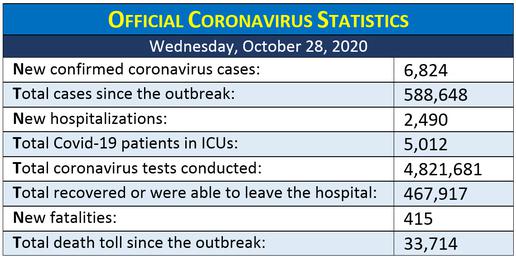
Dr. Lari also reported that all 31 Iranian provinces are in red, orange or yellow states of alert.
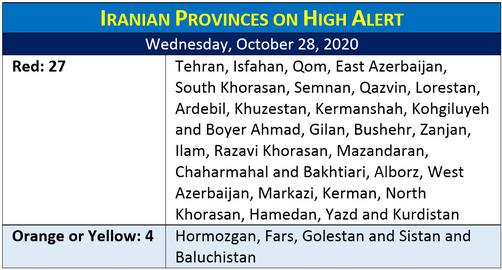
October 29: Iran’s New Coronavirus “Base of Operations” Takes Shape
As of Thursday, October 29, more than 5,000 Covid-19 patients were hospitalized in ICU wards across Iran. First deputy health minister Iraj Harirchi has said he believes more than half of these patients are likely to die. If Harirchi is correct in this dismal prediction, it means Iran’s official death toll from Covid-19 will soon stand at over 36,500. And these are just the official figures: most experts in public health in Iran now believe the real figure is likely to be double, triple or even quadruple the figure cited by health ministry spokeswoman Dr. Shima Sadat Lari each day.
By order of the Supreme Leader, a “base of operations” for the National Coronavirus Taskforce has now been created. President Rouhani has already appointed interior minister Abdolreza Rahmani Yazdi as its commander and Alireza Raeesi as its spokesman. On October 29, Rouhani also announced that Babak Din-Parast, current deputy minister for economy and regional development, would be its secretary.
The duties of this newly-formed “base of operations” include “facilitating and pursuing the prompt and accurate execution of decisions by the National Coronavirus Taskforce”, “codifying execution guidelines” and “taking advantage of the capabilities of social institutions such as mosques, the Basij, charities and others to support the execution of the National Coronavirus Taskforce’s decisions and to help the livelihood of vulnerable social strata”.
The brief for the new hub also mentions strengthening “the sense of public responsibility” to face up to the ongoing crisis as well as fostering “cooperation and empathy” between members of the public, the private sector, the executive and the military. Education programs are to be established “aimed at creating social trust and motivation regarding decisions made by the National Coronavirus Taskforce”. But the new base has an enforcement role as well; it also intends to augment the presence of what it called “bailiffs and supervisors” tasked with “encouraging” people to follow health guidelines.
Provinces Round-up
According to a recent edict from the National Coronavirus Taskforce, 50 percent of all workers in Tehran province, in both the public and private sectors, are now expected to be working remotely on alternating days. But the instruction is reportedly only being followed in government offices – and even then, not all of them – while many private sector employees in Tehran are still going to work as normal.
To date, 32 people working for 11 government agencies in Tehran province have died from Covid-19, reported Masoud Shafiei, president of Tehran’s Budget and Planning Organization.
Currently 6,125 Covid-19 patients are hospitalized across Tehran province and 700 are in a critical condition on ICU wards, reported Dr. Alireza Zali, head of the Tehran Coronavirus Taskforce. Dr. Zali added that since September 22, Tehran’s daily record for both new coronavirus infections and Covid-19 fatalities has been broken nine times. He also reported that on Wednesday, October 28, approximately 10,700 patients with Covid-19 symptoms had attended hospitals and clinics in Tehran.
In the past 24 hours, 24 people who tested positive for coronavirus have died in Kerman province. If those who had Covid-19 symptoms but were not confirmed cases are added to the total, between 40 and 50 patients are dying in this province at a minimum, reported Nozar Nakhaei, a member of Kerman University of Medical Science’s scientific staff. He also reported that close to 1,000 Covid-19 patients are currently in hospital in this province.
Infections and fatalities have been rising sharply in Alborz province in the past few weeks. Covid-19 has killed 19 people in the past 24 hours in this province while another 142 patients were admitted to hospital, bringing the total number of acute patients to 880. On October 29, Azizollah Shahbazi, the government’s high representative in Alborz, reported that restrictions in Alborz – including the closure of entertainment, sports, educational and religious centers – will be extended for another week.
Iran’s Latest Coronavirus Statistics
In her daily briefing for October 29, health ministry spokeswoman Dr. Sima Sadat Lari announced the official coronavirus statistics for the past 24 hours:

Dr. Lari also reported that all 31 Iranian provinces are in red, orange or yellow states of alert.
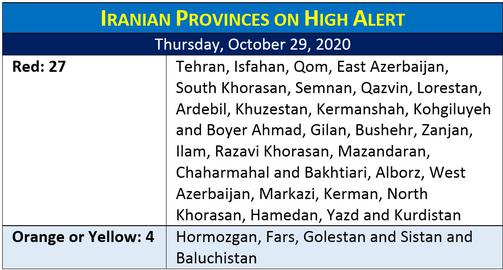
October 30:
Weekly Review of Coronavirus Disinformation in Iran: Health Official Line Up to Dispute Government Figures
In the eight months since the outbreak of coronavirus in Iran, many of the most bizarre pronouncements both about the virus and attempts to control it have come from Health Minister Saeed Namaki – especially when he is addressing either the Supreme Leader or the president of the Islamic Republic.
Since late September the official daily death toll has been rising day by day. On October 28, after the number of fatalities had risen above 400 for the first time, Namaki declared: “The vital support by the exalted Supreme Leader was the main factor in Iran’s success in fighting coronavirus.”
Namaki did not explain what form this “success” was supposed to have taken, at a time when Iran is being battered by a third wave of coronavirus. This is far from the first time the Health Minister has used his public platform to flatter Khamenei or Rouhani, perhaps in an attempt to bolster his own standing. In addition, Namaki has repeatedly claimed that in “other countries” patients have been left wandering outside hospitals and in parks whereas in Iran no patient has been left in the cold because of not being able to afford treatment.
These claims have consistently been proved wrong – both by the pictures and videos that regularly surface on social media, and by statements by other health and provincial officials. On October 7, for instance, Dr. Payam Tabarsi, head of infectious diseases at Tehran’s Masih Daneshvari Hospital, said “in the city of Tehran there are no longer any empty beds for coronavirus patients.”
Does Air Pollution Make Covid-19 Worse?
Since the summer there have been concerns that, with the arrival of the cold season, the number of coronavirus infections would rise at this time. Many believed that the drop in temperature would also intensify air pollution in metropolitan areas which, combined with the other factors, would eventually lead to a lockdown of big cities.
As of now, however, Iranian officials have made no specific decisions about how to cope with this scenario even though studies both in Iran and around the world have proven that air pollution leads to a rise in coronavirus deaths. Abbas Shahsavani, director of the Health Ministry’s Air Safety and Climate Change Workgroup, said on October 24: “Based on a study we conducted, we found that coronavirus deaths increase up to six percent by aerosol particles, up to seven percent by ozone and up to 15 percent by nitrogen dioxide. However, in countries such as China and Italy much higher numbers have been reported.” His statement is supported by international studies conducted in Western countries.
Nevertheless, on October 25, Ali Maher, deputy director of the Greater Tehran Coronavirus Taskforce, denied that air pollution has any effect on coronavirus patients. “Our research has not shown any connection between the two,” he said. Furthermore, he added, “there is no evidence that temperature has any effect on the rate of infections.” These contradictory statements only serve to bewilder the Iranian people, at a time when coherence and cohesion is paramount.
Eight Months of Misinformation
It was on February 19 that the ministry of health officially first announced the start of the coronavirus epidemic in Iran. Since then not a day has gone by without contradictory information being presented about the number of Covid-19 cases, hospitalizations and deaths. In the past week, a number of senior health officials have broken rank to announce that the official numbers are widely off the mark.
But it may be a case of too little, too late. Public trust in senior health figures in Iran is low because of the extent of obfuscation in the early days of the pandemic. October 20, Saeed Namaki unexpectedly revealed that he had known coronavirus was spreading in Iran a week before it was officially announced. “Three cases suspected of influenza after February 12 were [actually] coronavirus,” he said.
On October 25, Hossein Gheshlaghi, a member of the board of Iran’s Medical Council, said: “The rate of coronavirus fatalities in the country is approximately three to four times the official statistics.” This claim appears to be borne out by field reports from local medical centers, as well as burial figures.
Figures published by Tehran City Council, meanwhile, reveal that just in Tehran an average of 150 Covid-19 patients have been dying every day since February. This means that since the coronavirus outbreak more than 16,000 people in the nation’s capital have perished because of the pandemic.
Nevertheless, Dr. Minoo Moharez, a member of the National Coronavirus Taskforce’s Scientific Committee, has moved to defend the official statistics. The number of fatalities in the Iranian capital announced by Tehran City Council is based on reports that it receives from Behesht Zahra Cemetery. As such, Dr. Moharez asserted, “There are those whose coronavirus tests have been negative but CT scans have shown [symptoms]. Therefore, the city council’s numbers might be higher. The health ministry does not undercount fatalities but more than 30 percent of these people have tested negative so they are not included in the ministry’s figures.”
Neither announcement took account of the fact that some Iranians are dying at home before any form of hospital treatment or admission, let alone a coronavirus PCR test. Dr. Moharez herself also acknowledged that anywhere between 30 to 40 percent of negative test results could be “false negatives”. This is not an academic issue; misleading figures actively endangers the lives of Iranians whose behavior might well be different if they knew how serious the situation truly was.
Iran’s Latest Coronavirus Statistics
In her daily briefing for October 30, health ministry spokeswoman Dr. Sima Sadat Lari announced the official coronavirus statistics for the past 24 hours:
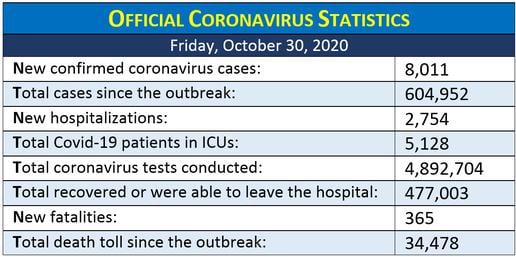
Dr. Lari also reported that all 31 Iranian provinces are in red, orange or yellow states of alert.
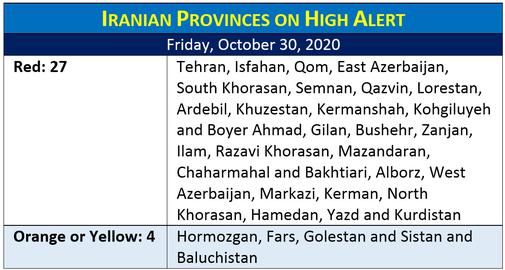
This is part of IranWire's coronavirus chronology. Read the full chronology
visit the accountability section
In this section of Iran Wire, you can contact the officials and launch your campaign for various problems




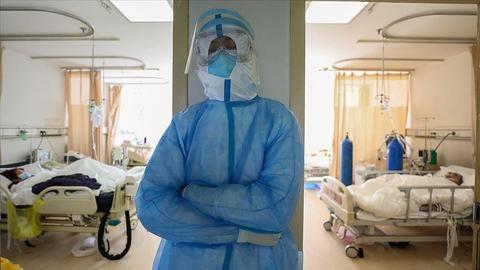





















comments